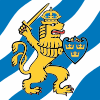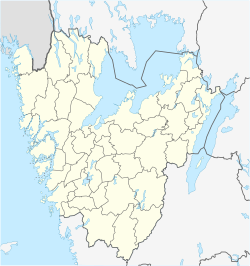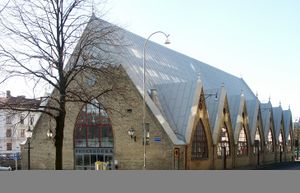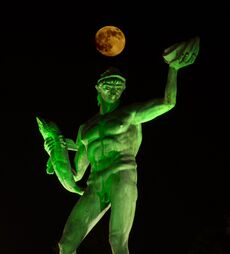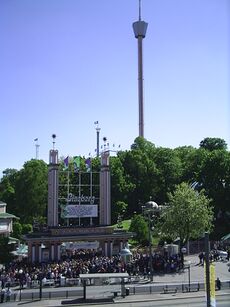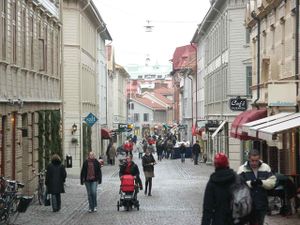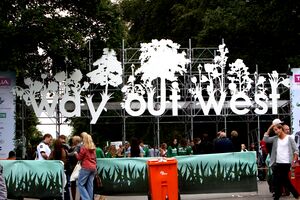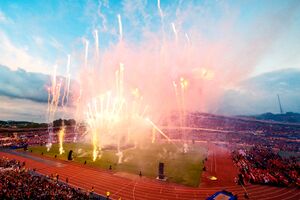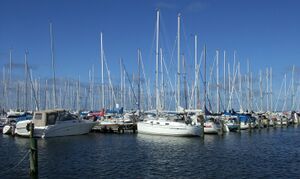غوتنبورغ
گوتنبورگ
Göteborg Gothenburg | |
|---|---|
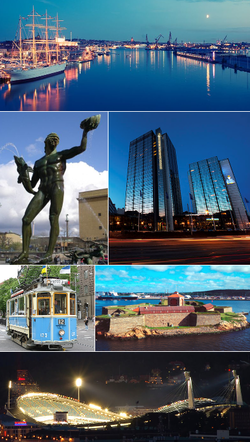 مع عقارب الساعة من أعلى: منظر عام لگوتنبورگ وگوتنا ألڤا، گوتاپلاستن، سڤنسكا ماسان، ترام گوتنبورگ الأثري، حصن ألڤسبورگ، أولڤي. | |
الكنية:
| |
| الإحداثيات: 57°42′27″N 11°58′03″E / 57.70750°N 11.96750°E | |
| البلد | السويد |
| المراكز | ڤستريوتلاند و Bohuslän |
| المقاطعة | مقاطعة ڤاسرتا گوتلاند |
| البلدية | بلدية گوتنبورگ, بلدية هاريدا، بلدية پارتيل و بلدية مولدندال |
| الميثاق | 1621 |
| المساحة | |
| • مدينة | 450 كم² (170 ميل²) |
| • الماء | 14٫5 كم² (5٫6 ميل²) 3.2% |
| • الحضر | 203٫67 كم² (78٫64 ميل²) |
| • العمران | 3٬717 كم² (1٬435 ميل²) |
| المنسوب | 12 m (39 ft) |
| التعداد | |
| • مدينة | 600٬000 |
| • الكثافة | 1٬300/km2 (3٬500/sq mi) |
| • Urban | 600٬473[3] |
| • العمرانية | 1٬070٬935 [2] |
| صفة المواطن | Göteborgare/Gothenburger |
| منطقة التوقيت | UTC+1 (توقيت وسط أوروپا) |
| • الصيف (التوقيت الصيفي) | UTC+2 (التوقيت الصيفي) |
| Postal code | 40xxx – 41xxx – 421xx – 427xx |
| مفتاح الهاتف | (+46) 31 |
| الموقع الإلكتروني | |
گوتنبورگ (سويدية: Göteborg؛ تُنطق [jœtəˈbɔrj] (![]() استمع)؛ إنگليزية: Gothenburg) هي ثاني أكبر مدينة في السويد حسب تعداد السكان وخامس أكبر مدينة في البلدان النوردية. وتقع على الساحل الغربي للسويد، والمدينة ذاتها يبلغ تعداد سكانها 524,767، بينما يبلغ التعداد 549,839 في المنطقة الحضرية وإجمالي 945,713 نسمة في بمنطقتها العمرانية.[1] وتُصنّف گوتنبورگ كمدينة عالمية حسب GaWC، بترتيب گاما−.[5]
استمع)؛ إنگليزية: Gothenburg) هي ثاني أكبر مدينة في السويد حسب تعداد السكان وخامس أكبر مدينة في البلدان النوردية. وتقع على الساحل الغربي للسويد، والمدينة ذاتها يبلغ تعداد سكانها 524,767، بينما يبلغ التعداد 549,839 في المنطقة الحضرية وإجمالي 945,713 نسمة في بمنطقتها العمرانية.[1] وتُصنّف گوتنبورگ كمدينة عالمية حسب GaWC، بترتيب گاما−.[5]
مدينة گوتنبورگ أسسها في 1621 الملك گوستاڤوس أدولفوس. وتطل على البحر عند مصب گوتا ألڤ—النهر الذي يجري عبر المدينة—وهي أكبر ميناء بحري في البلدان النوردية.[6]
وتضم گوتنبورگ الكثير من الطلاب، لأن فيها كل من جامعة گوتنبورگ وجامعة تشالمرز للتكنولوجيا. ڤولڤو تأسست في گوتنبورگ في 1927.[7] وتُعـَد المدينة مركزاً رئيسياً في السويد للرياضة وهي مقر لفرق كرة القدم IFK Göteborg, BK Häcken, GAIS و Örgryte IS وكذلك فريق Frölunda HC لهوكي الجليد.
گوتنبورگ يخدمها مطار گوتنبورگ-لاندڤتر، الوافع على بعد 30 كم جنوب شرق مركز المدينة. وهو ثاني أكبر مطار في السويد. كما يوجد في المدينة مطار مدينة گوتنبورگ، الواقع على بعد 15 كم من مركز المدينة.
تشتهر المدينة باستضافة بعض الفعاليات السنوية وغير السنوية في سكندناڤيا، مما جعل گوتنبورگ تحصل على كنية "مدينة الأحداث". مهرجن گوتنبورگ السينمائي، يعقد في يناير منذ عام 1979، وهو من أبرز المهرجانات السينمائية في سكانديناڤيا يحضره أكثر من 155.000 زائر سنوياً.[8] في الصيف تقام مجموعة متنوعة من المهرجانات الموسيقيى، مثل واي أوت وست ومتالتاون. يقام سنوياً في گوتنبورگ كأس گوثيا ويعتبر من بطولات كرة القدم في العالم: 2011، شارك فيه 35.200 لاعب من 1567 فريق و72 دولة. بالإضافة إلى ذلك، يقع اختيار الكثير من الفنانين على گوتنبورگ لاستضافة حفلاتهم الموسيقي بدلاً من المدن السويدية الاخرى مثل ستوكهولم ومالمو.[بحاجة لمصدر]
وتشتهر گوتنبورگ أيضاً بمنتزه ليسبرگ، وقد اختارته مجلة فوربس كواحد من أفضل عشرة منتزهات ترفيهية في العالم عام 2005.[9]
الاسم
سميت المدينة على اسم قبيلة گيتس (بالسويدية Götar أو: Geatas، Gautar، قوط، Gotar، Gøtar، Götar)، سكان گوثيا، شمال غرب السويد حاليأً.[10] النهر الذي يقع في المدينة هو نهر گوتا ألڤ أو نهر گوثيا. ويقع حصن گوثيا على نهر گوتا، وبنيت لحماية الميناء، الذي كان نافذة السويد التجارية على الغرب.[بحاجة لمصدر]
اللغة الهولندية، الاسكتلندية والإنگليزية، لديها جميعها تاريخ في تلك المدينة التجارية البحرية. يستخدم اسم گوتنبورگ تقليدياً لوصف المدينة في مهرجان گوتنبورگ السينمائي. يستخدم النطق الفرنسي للمدينة گوتبورگ Göteborg على نطاق أوسع.
التاريخ
 مقالة مفصلة: تاريخ گوتنبورگ
مقالة مفصلة: تاريخ گوتنبورگ

In the early modern period, the configuration of Sweden's borders made Gothenburg strategically critical as the only Swedish gateway to Skagerrak, the North Sea and Atlantic, situated on the west coast in a very narrow strip of Swedish territory between Danish Halland in the south and Norwegian Bohuslän in the north. After several failed attempts, Gothenburg was successfully founded in 1621 by King Gustavus Adolphus (Gustaf II Adolf).[11]
The site of the first church built in Gothenburg, subsequently destroyed by Danish invaders, is marked by a stone near the north end of the Älvsborg Bridge in the Färjenäs Park. The church was built in 1603 and destroyed in 1611.[12] The city was heavily influenced by the Dutch, Germans, and Scots, and Dutch planners and engineers were contracted to construct the city as they had the skills needed to drain and build in the marshy areas chosen for the city. The town was designed like Dutch cities such as Amsterdam, Batavia (Jakarta) and New Amsterdam (Manhattan).[11] The planning of the streets and canals of Gothenburg closely resembled that of Jakarta, which was built by the Dutch around the same time.[13] The Dutchmen initially won political power, and it was not until 1652, when the last Dutch politician in the city's council died, that Swedes acquired political power over Gothenburg.[14] During the Dutch period, the town followed Dutch town laws and Dutch was proposed as the official language in the town. Robust city walls were built during the 17th century. In 1807, a decision was made to tear down most of the city's wall. The work started in 1810 and was carried out by 150 soldiers from the Bohus regiment.[15]
Along with the Dutch, the town also was heavily influenced by Scots who settled down in Gothenburg. Many became people of high-profile.[16] William Chalmers, the son of a Scottish immigrant, donated his fortunes to set up what later became the Chalmers University of Technology.[17] In 1841, the Scotsman Alexander Keiller founded the Götaverken shipbuilding company that was in business until 1989.[18] His son James Keiller donated Keiller Park to the city in 1906.[19]
The Gothenburg coat of arms was based on the lion of the coat of arms of Sweden, symbolically holding a shield with the national emblem, the Three Crowns, to defend the city against its enemies.[20]
In the Treaty of Roskilde (1658), Denmark–Norway ceded the Danish province of Halland, in the south, and the Norwegian province of Bohus County or Bohuslän in the north, which left Gothenburg less exposed. Gothenburg grew into a significant port and trade centre on the west coast, because it was the only city on the west coast that, along with Marstrand, was granted the rights to trade with merchants from other countries.[14]
In the 18th century, fishing was the most important industry. However, in 1731, the Swedish East India Company was founded, and the city flourished due to its foreign trade with highly profitable commercial expeditions to China.[21]
The harbour developed into Sweden's main harbour for trade towards the west, and when Swedish emigration to the United States increased, Gothenburg became Sweden's main point of departure for these travellers. The impact of Gothenburg as a main port of embarkation for Swedish emigrants is reflected by Gothenburg, Nebraska, a small Swedish settlement in the United States.[22]
With the 19th century, Gothenburg evolved into a modern industrial city that continued on into the 20th century. The population increased tenfold in the century, from 13,000 (1800) to 130,000 (1900).[23][24][25] In the 20th century, major companies that developed included SKF (1907)[26] and Volvo (1927).[27]
الجغرافيا
Gothenburg is located on the west coast, in southwestern Sweden, about halfway between the capital cities of Copenhagen (Denmark) and Oslo (Norway). The location at the mouth of the Göta älv, which feeds into the Kattegat, an arm of the North Sea, has helped the city grow in significance as a trading city. The archipelago of Gothenburg consists of rough, barren rocks and cliffs, which also is typical for the coast of Bohuslän.[28] Due to the Gulf Stream, the city has a mild climate and moderately heavy precipitation.[29] It is the second-largest city in Sweden after its capital Stockholm.[30]
The Gothenburg Metropolitan Area (Stor-Göteborg) has 982,360 inhabitants and extends to the municipalities of Ale, Alingsås, Göteborg, Härryda, Kungälv, Lerum, Lilla Edet, Mölndal, Partille, Stenungsund, Tjörn, Öckerö within Västra Götaland County, and Kungsbacka within Halland County.[31]
Angered, a suburb outside Gothenburg, consists of Hjällbo, Eriksbo, Rannebergen, Hammarkullen, Gårdsten, and Lövgärdet.[32] It is a Million Programme part of Gothenburg, like Rosengård in Malmö and Botkyrka in Stockholm.[33] Angered had about 50,000 inhabitants in 2015.[34][?] It lies north of Gothenburg and is isolated from the rest of the city. Bergsjön is another Million Programme suburb north of Gothenburg, it has 14,000 inhabitants. Biskopsgården is the biggest multicultural suburb on the island of Hisingen, which is a part of Gothenburg but separated from the city by the river.
المناخ
Gothenburg has an oceanic climate (Cfb according to the Köppen climate classification). Despite its northerly latitude, temperatures are quite mild throughout the year and warmer than places at a similar latitude such as Stockholm; this is mainly because of the moderating influence of the Gulf Stream.[29] During the summer, daylight extends 18 hours and 5 minutes, but lasts 6 hours and 32 minutes in late December. The climate has become significantly milder in later decades, particularly in summer and winter; July temperatures used to be below Stockholm's 1961–1990 averages, but have since been warmer than that benchmark.
Summers are warm and pleasant with average high temperatures of 20 إلى 22 °C (68 إلى 72 °F) and lows of 12 إلى 15 °C (54 إلى 59 °F), but temperatures of 25–30 °C (77–86 °F) occur on many days during the summer. Winters are cold and windy with temperatures of around −1 إلى 4 °C (30 إلى 39 °F), though it rarely drops below −20 °C (−4 °F). Precipitation is regular but generally moderate throughout the year. Snow mainly occurs from December to March, but is not unusual in November and April and can sometimes occur even in October and May.[35]
| بيانات المناخ لـ گوتنبورگ | |||||||||||||
|---|---|---|---|---|---|---|---|---|---|---|---|---|---|
| الشهر | ينا | فب | مار | أبر | ماي | يون | يول | أغس | سبت | أكت | نوف | ديس | السنة |
| القصوى القياسية °س (°ف) | 10 (50) |
10 (50) |
19 (66) |
28 (82) |
30 (86) |
34 (93) |
33 (91) |
34 (93) |
29 (84) |
21 (70) |
13 (55) |
10 (50) |
34 (93) |
| متوسط القصوى اليومية °س (°ف) | 1 (34) |
1 (34) |
5 (41) |
9 (48) |
16 (61) |
19 (66) |
20 (68) |
20 (68) |
16 (61) |
11 (52) |
6 (43) |
3 (37) |
10.5 (50.9) |
| متوسط الدنيا اليومية °س (°ف) | −4 (25) |
−5 (23) |
−2 (28) |
1 (34) |
6 (43) |
10 (50) |
12 (54) |
12 (54) |
8 (46) |
6 (43) |
1 (34) |
−3 (27) |
3.4 (38.1) |
| الصغرى القياسية °س (°ف) | −26 (−15) |
−26 (−15) |
−19 (−2) |
−10 (14) |
−4 (25) |
1 (34) |
6 (43) |
2 (36) |
−3 (27) |
−7 (19) |
−16 (3) |
−22 (−8) |
−26 (−15) |
| متوسط تساقط الأمطار mm (inches) | 62 (2.4) |
41 (1.6) |
50 (2.0) |
42 (1.7) |
51 (2.0) |
61 (2.4) |
68 (2.7) |
77 (3.0) |
81 (3.2) |
84 (3.3) |
84 (3.3) |
75 (3.0) |
776 (30.6) |
| Average precipitation days | 15 | 12 | 10 | 12 | 10 | 12 | 14 | 14 | 16 | 15 | 16 | 17 | 163 |
| Mean monthly ساعات سطوع الشمس | 40 | 71 | 126 | 182 | 241 | 266 | 243 | 220 | 143 | 94 | 58 | 38 | 1٬722 |
| [بحاجة لمصدر] | |||||||||||||
| Climate data for Gothenburg | |||||||||||||
|---|---|---|---|---|---|---|---|---|---|---|---|---|---|
| Month | Jan | Feb | Mar | Apr | May | Jun | Jul | Aug | Sep | Oct | Nov | Dec | Year |
| Average sea temperature °C (°F) | 4.0 |
3.0 |
2.7 |
6.8 |
11.2 |
15.5 |
18.0 |
18.5 |
16.5 |
12.4 |
9.2 |
6.1 |
10.3 |
| Mean daily daylight hours | 7.0 | 10.0 | 12.0 | 14.0 | 17.0 | 18.0 | 17.0 | 15.0 | 13.0 | 10.0 | 9.0 | 7.0 | 12.4 |
| Average Ultraviolet index | 0 | 1 | 2 | 4 | 5 | 6 | 6 | 5 | 4 | 2 | 1 | 0 | 3 |
| Source: Weather Atlas[37] | |||||||||||||
المنتزهات والطبيعة
Gothenburg has several parks and nature reserves ranging in size from tens of square meters to hundreds of hectares. It also has many green areas that are not designated as parks or reserves.
مختارات من المنتزهات:
- Kungsparken, 13 ha (32 acre), built between 1839 and 1861, surrounds the canal that circles the city centre.[38]
- Garden Society of Gothenburg, a park and horticultural garden, is located next to Kungsportsavenyen. Founded in 1842 by the Swedish king Carl XIV Johan and on initiative of the amateur botanist Henric Elof von Normann, the park has a noted rose garden with some 4,000 roses of 1,900 cultivars.[39]
- Slottsskogen, 137 ha (340 acre), was created in 1874 by August Kobb. It has a free "open" zoo that includes harbor seals, penguins, horses, pigs, deer, moose, goats, and many birds. The Natural History Museum (Naturhistoriska Museet) and the city's oldest observatory are located in the park.[39] The annual Way Out West festival is held in the park.[40]
- Änggårdsbergens naturreservat, 320 ha (790 acre), was bought in 1840 by pharmacist Arvid Gren, and donated in 1963 to the city by Sven and Carl Gren Broberg, who stated the area must remain a nature and bird reserve. It lies partly in Mölndal.[41]
- Delsjöområdets naturreservat, about 760 ha (1،900 acre),[42] has been in use since the 17th century as a farming area; significant forest management was carried out in the late 19th century. Skatås gym and motionscentrum is situated here.
- Rya Skogs Naturreservat, 17 ha (42 acre), became a protected area in 1928. It contains remnants of a defensive wall built in the mid- to late-17th century.[43]
- Keillers park was donated by James Keiller in 1906. He was the son of Scottish Alexander Keiller, who founded the Götaverken shipbuilding company.[19][32]
- S A Hedlunds park: Sven Adolf Hedlund, newspaper publisher and politician, bought the 15 ha (37 acre) Bjurslätt farm in 1857, and in 1928 it was given to the city.
- Hisingsparken is Gothenburg's largest park.[44]
- Flunsåsparken, built in 1950, has many free activities during the summer such as concerts and theatre.[45]
- Gothenburg Botanical Garden, 175 ha (430 acre), opened in 1923.[46] It won an award in 2003, and in 2006 was third in "The most beautiful garden in Europe" competition. It has around 16,000 species of plants and trees. The greenhouses contain around 4,500 species including 1,600 orchids.[39] It is considered to be one of the most important botanical gardens in Europe with three stars in the French Guide Rouge.
العمارة

Very few buildings are left from the 17th century when the city was founded, since all but the military and royal houses were built of wood.[47] Some structures which do survive from this early phase in the city's history are Kronhuset and the Torstenson Palace, and the fortresses Skansen Kronan[48] and Skansen Lejonet.
The first major architecturally interesting period is the 18th century when the East India Company made Gothenburg an important trade city. Imposing stone houses in Neo-Classical style were erected around the canals. One example from this period is the East India House, which today houses the Göteborg City Museum.[49]
In the 19th century, the wealthy bourgeoisie began to move outside the city walls which had protected the city. The style now was an eclectic, academic, somewhat overdecorated style which the middle-class favoured. The working class lived in the overcrowded city district Haga in wooden houses.[50]
In the 19th century, the first comprehensive town plan after the founding of city was created, which led to the construction of the main street, Kungsportsavenyen.[51] Perhaps the most significant type of houses of the city, Landshövdingehusen, were built in the end of the 19th century – three-storey houses with the first floor in stone and the other two in wood.[52]
The early 20th century, characterized by the National Romantic style, was rich in architectural achievements.[50] Masthugg Church is a noted example of the style of this period.[53][54] In the early 1920s, on the city's 300th anniversary, the Götaplatsen square with its Neoclassical look was built.[50]
After this, the predominant style in Gothenburg and rest of Sweden was Functionalism which especially dominated the suburbs such as Västra Frölunda and Bergsjön. The Swedish functionalist architect Uno Åhrén served as city planner from 1932 through 1943.[50] In the 1950s, the big stadium Ullevi was built when Sweden hosted the 1958 FIFA World Cup.[55]
The modern architecture of the city has been formed by such architects as Gert Wingårdh,[56] who started as a Post-modernist in the 1980s.[57]
Gustaf Adolf Square is a town square located in central Gothenburg. Noted buildings on the square include Gothenburg City Hall (formerly the stock exchange, opened in 1849) and the Nordic Classicism law court. The main canal of Gothenburg also flanks the square.[50]
مباني مميزة

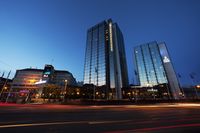
The Gothenburg Central Station is in the centre of the city, next to Nordstan and Drottningtorget.[58] The building has been renovated and expanded numerous times since the grand opening in October 1858. In 2003, a major reconstruction was finished which brought the 19th-century building into the 21st century expanding the capacity for trains, travellers, and shopping.[59] Not far from the central station is the Skanskaskrapan, or more commonly known as "The Lipstick". It is 86 m (282 ft) high with 22 floors and coloured in red-white stripes. The skyscraper was designed by Ralph Erskine and built by Skanska in the late 1980s as the headquarters for the company.[60]
By the shore of the Göta Älv at Lilla Bommen is The Göteborg Opera. It was completed in 1994. The architect Jan Izikowitz was inspired by the landscape and described his vision as "Something that makes your mind float over the squiggling landscape like the wings of a seagull."[61]
Feskekörka, or Fiskhallen, is an indoor fishmarket by the Rosenlundskanalen in central Gothenburg. Feskekörkan was opened on 1 November 1874 and its name from the building's resemblance to a Gothic church.[62] The Gothenburg city hall is in the Beaux-Arts architectural style. The Gothenburg Synagogue at Stora Nygatan, near Drottningtorget, was built in 1855 according to the designs of the German architect August Krüger.[63]
The Gunnebo House is a country house located to the south of Gothenburg, in Mölndal. It was built in a neoclassical architecture towards the end of the 18th century.[64] Created in the early 1900s was the Vasa Church. It is located in Vasastan and is built of granite in a neo-Romanesque style.[65]
Another noted construction is Brudaremossen TV Tower, one of the few partially guyed towers in the world.[66]
الثقافة
The sea, trade, and industrial history of the city are evident in the cultural life of Gothenburg.[67] It is also a popular destination for tourists on the Swedish west coast.
Museums
Many of the cultural institutions, as well as hospitals and the university, were created by donations from rich merchants and industrialists, for example the Röhsska Museum.[68] On 29 December 2004, the Museum of World Culture opened near Korsvägen.[69][70] Museums include the Göteborgs Konsthall, Gothenburg Museum of Art, and several museums of sea and navigation history, natural history, the sciences, and East India.[71] Aeroseum, close to the Göteborg City Airport, is an aircraft museum in a former military underground air force base.[72] The Volvo museum has exhibits of the history of Volvo and the development from 1927 until today. Products shown include cars, trucks, marine engines, and buses.[73]
Universeum is a public science centre that opened in 2001, the largest of its kind in Scandinavia. It is divided into six sections, each containing experimental workshops and a collection of reptiles, fish, and insects.[74] Universeum occasionally host debates between Swedish secondary-school students and Nobel Prize laureates or other scholars.[75]
Leisure and entertainment
The most noted attraction is the amusement park Liseberg, located in the central part of the city. It is the largest amusement park in Scandinavia by number of rides,[76] and was chosen as one of the top ten amusement parks in the world (2005) by Forbes.[77] It is the most popular attraction in Sweden by number of visitors per year (more than 3 million).[78]
There are a number of independent theatre ensembles in the city, besides institutions such as Gothenburg City Theatre, Backa Theatre (youth theatre), and Folkteatern.[79]
The main boulevard is called Kungsportsavenyn (commonly known as Avenyn, "The Avenue"). It is about 1 km (0.6 mi) long and starts at Götaplatsen – which is the location of the Gothenburg Museum of Art, the city's theatre, and the city library, as well as the concert hall – and stretches all the way to Kungsportsplatsen in the old city centre of Gothenburg, crossing a canal and a small park.[80] The Avenyn was created in the 1860s and 1870s as a result of an international architecture contest, and is the product of a period of extensive town planning and remodelling.[81] Avenyn has Gothenburg's highest concentration of pubs and clubs. Gothenburg's largest shopping centre (8th largest in Sweden), Nordstan, is located in central Gothenburg.[82]
Gothenburg's Haga district is known for its picturesque wooden houses[78] and its cafés serving the well-known Haga bulle – a large cinnamon roll similar to the kanelbulle.[83]
Five Gothenburg restaurants have a star in the 2008 Michelin Guide: 28 +, Basement, Fond, Kock & Vin, Fiskekrogen, and Sjömagasinet.[84] The city has a number of star chefs – over the past decade, seven of the Swedish Chef of the Year awards have been won by people from Gothenburg.[85]
The Gustavus Adolphus pastry, eaten every 6 November in Sweden, Gustavus Adolphus Day, is especially connected to, and appreciated in, Gothenburg because the city was founded by King Gustavus Adolphus.[86]
One of Gothenburg's most popular natural tourist attractions is the southern Gothenburg archipelago, which is a set of several islands that can be reached by ferry boats mainly operating from Saltholmen. Within the archipelago are the Älvsborg fortress, Vinga and Styrsö islands.[78]
Festivals and fairs

The annual Gothenburg Film Festival, is the largest film festival in Scandinavia.[87] The Gothenburg Book Fair, held each year in September.[88] It is the largest literary festival in Scandinavia, and the second largest book fair in Europe.[89] A radical bookfair is held at the same time at the Syndikalistiskt Forum.[90]
The International Science Festival in Gothenburg is an annual festival since April 1997, in central Gothenburg with thought-provoking science activities for the public. The festival is visited by about 100,000 people each year.[91] This makes it the largest popular-science event in Sweden[92] and one of the leading popular-science events in Europe.[93]
Citing the financial crisis, the International Federation of Library Associations and Institutions moved the 2010 World Library and Information Congress, previously to be held in Brisbane, Australia, to Gothenburg. The event took place on 10–15 August 2010.[94]
Music
Gothenburg has a diverse music community—the Gothenburg Symphony Orchestra is the best-known in classical music.[95] Gothenburg also was the birthplace of the Swedish composer Kurt Atterberg.[96] The first internationally successfully Swedish group, instrumental rock group The Spotnicks came from Gothenburg.[97]
Bands such as The Soundtrack of Our Lives[98] and Ace of Base are well-known pop representatives of the city. During the 1970s, Gothenburg had strong roots in the Swedish progressive movement (progg) with such groups as Nationalteatern, Nynningen, and Motvind. The record company Nacksving and the editorial office for the magazine Musikens Makt which also were part of the progg movement were located in Gothenburg during this time as well.[99]
There is also an active indie scene in Gothenburg. For example, the musician Jens Lekman was born in the suburb of Angered[100] and named his 2007 release Night Falls Over Kortedala after another suburb, Kortedala.[101] Other internationally acclaimed indie artists include the electro pop duos Studio,[102] The Knife,[103] Air France,[104] The Tough Alliance,[105] indie rock band Love is All, songwriter José González,[106] and pop singer El Perro del Mar,[107] as well as genre-bending quartet Little Dragon fronted by vocalist Yukimi Nagano.[108] Another son of the city is one of Sweden's most popular singers, Håkan Hellström, who often includes many places from the city in his songs.[109][110] The glam rock group Supergroupies derives from Gothenburg.[111]
Gothenburg's own commercially successful At the Gates, In Flames, and Dark Tranquillity are credited with pioneering melodic death metal.[112] Other well-known bands of the Gothenburg scene are thrash metal band The Haunted,[113] progressive power metal band Evergrey,[114] and power metal bands HammerFall and Dream Evil.[115]
Many music festivals take place in the city every year. The Metaltown Festival was a two-day festival featuring heavy metal music bands, held in Gothenburg. It used to be arranged annually since 2004, taking place at the Frihamnen venue.[116] In June 2012, the festival included bands such as In Flames, Marilyn Manson, Slayer, Lamb of God, and Mastodon.[117] Another popular festival, Way Out West, focuses more on rock, electronic, and hip-hop genres.[118][119]
Sports
As in all of Sweden, a variety of sports are followed, including football, ice hockey, basketball, handball, floorball, baseball, and figure skating. A varied amateur and professional sports clubs scene exists.[120]
Gothenburg is the birthplace of football in Sweden as the first football match in Sweden was played there in 1892.[121] The city's three major football clubs, IFK Göteborg, Örgryte IS, and GAIS[122] share a total of 34 Swedish championships between them.[123] IFK has also won the UEFA Cup twice.[124] Other notable clubs include BK Häcken (football),[125] Göteborg HC (women's ice hockey), Pixbo Wallenstam IBK (floorball),[126] multiple national handball champion Redbergslids IK,[127] and five-time national ice hockey champion Frölunda HC,[128] Gothenburg had a professional basketball team, Gothia Basket, until 2010 when it ceased.[129] The bandy department of GAIS, GAIS Bandy, played the first season in the highest division Elitserien last season. The group stage match between the main rivals Sweden and Russia in the 2013 Bandy World Championship was played at Arena Heden in central Gothenburg.[130]
The city's most notable sports venues are Scandinavium,[131] and Ullevi (multisport) and the newly built Gamla Ullevi[132] (football).
The 2003 World Allround Speed Skating Championships were held in Rudhallen, Sweden's only indoor speed-skating arena.[133] It is a part of Ruddalens IP, which also has a bandy field and several football fields.[134]
The only Swedish heavyweight champion of the world in boxing, Ingemar Johansson, who took the title from Floyd Paterson in 1959, was from Gothenburg.[135]
Gothenburg has hosted a number of international sporting events including the 1958 FIFA World Cup,[55] the 1983 European Cup Winners' Cup Final,[136] an NFL preseason game on 14 August 1988 between the Chicago Bears and the Minnesota Vikings,[137] the 1992 European Football Championship, the 1993[138] and the 2002 World Men's Handball Championship,[139] the 1995 World Championships in Athletics,[140] the 1997 World Championships in Swimming (short track),[141] the 2002 Ice Hockey World Championships,[139] the 2004 UEFA Cup final,[142] the 2006 European Championships in Athletics,[143] and the 2008 World Figure Skating Championships.[144] Annual events held in the city are the Gothia Cup[145] and the Göteborgsvarvet.[146] The annual Gothia Cup, is the world's largest football tournament with regards to the number of participants: in 2011, a total of 35,200 players from 1,567 teams and 72 nations participated.
Gothenburg hosted the XIII FINA World Masters Championships in 2010.[147] Diving, swimming, synchronized swimming and open-water competitions were held on 28 July to 7 August. The water polo events were played on the neighboring city of Borås.[148]
Gothenburg is also home to the Gothenburg Sharks, a professional baseball team in the Elitserien division of baseball in Sweden.[149]
With around 25,000 sailboats and yachts scattered about the city, sailing is a popular sports activity in the region, particularly because of the nearby Gothenburg archipelago.[150] In June 2015, the Volvo Ocean Race, professional sailing's leading crewed offshore race, concluded in Gothenburg,[151] as well as an event in the 2015–2016 America's Cup World Series in August 2015.[152]
The Gothenburg Amateur Diving Club (Göteborgs amatördykarklubb) has been operating since October 1938.
الاقتصاد
Due to Gothenburg's advantageous location in the centre of Scandinavia, trade and shipping have always played a major role in the city's economic history, and they continue to do so. Gothenburg port has come to be the largest harbour in Scandinavia.[6]
Apart from trade, the second pillar of Gothenburg has traditionally been manufacturing and industry, which significantly contributes to the city's wealth.[153] Major companies operating plants in the area include SKF, Volvo (both cars and trucks), and Ericsson. Volvo Cars is the largest employer in Gothenburg, not including jobs in supply companies. The blue-collar industries which have dominated the city for long are still important factors in the city's economy, but they are being gradually replaced by high-tech industries.[154][155]
Banking and finance are also important, as well as the event and tourist industry.[6]
Gothenburg is the terminus of the Valdemar-Göteborg gas pipeline, which brings natural gas from the North Sea fields to Sweden, through Denmark.[156]
Historically, Gothenburg was home base from the 18th century of the Swedish East India Company.[157] From its founding until the late 1970s, the city was a world leader in shipbuilding, with such shipyards as Eriksbergs Mekaniska Verkstad, Götaverken, Arendalsvarvet, and Lindholmens varv.[158] Gothenburg is classified as a global city by GaWC, with a ranking of Gamma.[159] The city has been ranked as the 12th-most inventive city in the world by Forbes.[160]
الحكومة
Gothenburg became a city municipality with an elected city council when the first Swedish local government acts were implemented in 1863.[161] The municipality has an assembly consisting of 81 members,[162] elected every fourth year.[163] Political decisions depend on citizens considering them legitimate. Political legitimacy can be based on various factors: legality, due process, and equality before the law, as well as the efficiency and effectiveness of public policy. One method used to achieve greater legitimacy for controversial policy reforms such as congestion charges is to allow citizens to decide or advise on the issue in public referendums.
In December 2010 a petition for a local referendum on the congestion tax, signed by 28,000 citizens, was submitted to the City Council. This right to submit so-called "people's initiatives" was inscribed in the Local Government Act, which obliged local governments to hold a local referendum if petitioned by 5% of the citizens unless the issue was deemed to be outside their area of jurisdiction or if a majority in the City Council voted against holding such a referendum.[164] A second petition for a referendum, signed by 57,000 citizens, was submitted to the local government in February 2013. This petition followed a campaign organised by a local newspaper – Göteborgs Tidningen – whose editor-in-chief argued that the paper's involvement was justified by the large public response to a series of articles on the congestion tax, as well as out of concern for the local democracy.[165][164]
السكان
| Largest groups of foreign residents[166] | |
| المولودون بالخارج | التعداد (2021) |
|---|---|
| 12,999 | |
| 12,902 | |
| 9,756 | |
| 8,839 | |
| 7,639 | |
| 7,151 | |
| 5,901 | |
| 5,539 | |
| 5,382 | |
| 4,315 | |
| 3,685 | |
| 3,117 | |
| 2,975 | |
| 2,691 | |
| 2,474 | |
In 2019, approximately 28% (159,342 residents) of the population of Gothenburg were foreign born and approximately 46% (265,019 residents) had at least one parent born abroad.[167] In addition, approximately 12% (69,263 residents) were foreign citizens.[168]
In 2016, 45% of Gothenburg's immigrant population is from other parts of Europe, and 10% of the total population is from another Nordic country.[169]
التعليم
Gothenburg has two universities, both of which started as colleges founded by private donations in the 19th century. The University of Gothenburg has about 38,000 students and is one of the largest universities in Scandinavia,[170] and one of the most versatile in Sweden. Chalmers University of Technology is a well-known university located in Johanneberg 2 km (1 mi) south of the inner city, lately also established at Lindholmen in Norra Älvstranden, Hisingen.[171]
In 2015, there were ten adult education centres in Gothenburg: Agnesbergs folkhögskola, Arbetarrörelsens folkhögskola i Göteborg, Finska folkhögskolan, Folkhögskolan i Angered, Göteborgs folkhögskola, Kvinnofolkhögskolan, Mo Gård folkhögskola, S:ta Birgittas folkhögskola, Västra Götalands folkhögskolor and Wendelsbergs folkhögskola.[172]
In 2015, there were 49 high schools in Gothenburg. Some of the more notable schools are Hvitfeldtska gymnasiet, Göteborgs Högre Samskola, Sigrid Rudebecks gymnasium and Polhemsgymnasiet. Some high-schools are also connected to large Swedish corporations, such as SKF Technical high-school owned by SKF and Gothenburg's technical high-school jointly owned by Volvo, Volvo Cars and Gothenburg municipality.[173]
There are two folkhögskola that teach fine arts: Domen and Goteborg Folkhögskola.
الترتيب العالمي
Gothenburg has performed well in international rankings, some of which are mentioned below: The Global Destination Sustainability Index has named Gothenburg the world's most sustainable destination every year since 2016.[174]
In 2019 Gothenburg was selected by the EU as one of the top 2020 European Capitals of Smart Tourism.[175]
In 2020 Business Region Göteborg received the 'European Entrepreneurial Region Award 2020' (EER Award 2020) from the EU.[175]
العلاقات الدولية
The Gothenburg Award is the city's international prize that recognises and supports work to achieve sustainable development – in the Gothenburg region and from a global perspective.[176] The award, which is one million Swedish crowns, is administered and funded by a coalition of the City of Gothenburg and 12 companies.[177] Past winners of the award have included Kofi Annan, Al Gore, and Michael Biddle.[178]
المدن الشقيقة
|
With Lyon (France) there is no formal partnership, but "a joint willingness to cooperate".[181] Gothenburg had signed an agreement with Shanghai in 1986 which was upgraded in 2003 to include exchanges in culture, economics, trade and sport. The agreement was allowed to lapse in 2020.[182]
انظر أيضاً
- گوتنبورگ العمرانية
- أرخبيل گوتنبورگ
- پورتوكول گوتنبورگ
- أكبر المناطق الحضرية الأوروپية
- أكبر مدن الاتحاد الأوروپي من حيث السكان وحدود المدينة
الهامش
- ^ أ ب ت "Localities 2010, area, population and density in localities 2005 and 2010 and change in area and population". Statistics Sweden. 29 May 2012. Archived from the original on 17 December 2012.
{{cite web}}: Unknown parameter|deadurl=ignored (|url-status=suggested) (help) - ^ "Folkmängd i riket, län och kommuner 31 december 2021 och befolkningsförändringar 1 oktober –31 december 2021. Totalt". Archived from the original on 18 March 2022.
- ^ "Population in localities increased by 120 000". Statistiska Centralbyrån (in الإنجليزية). Archived from the original on 15 November 2017. Retrieved 15 November 2017.
- ^ "Kvartal 2 2014". Statistiska Centralbyrån. Archived from the original on 14 August 2014.
- ^ GaWC - The World According to GaWC 2010
- ^ أ ب ت Swedish National Encyclopedia (password needed)
- ^ Volvo group history: Volvo's founders
- ^ Info on the Festival site
- ^ Forbes.com
- ^ Hellquist, E. Svensk etymologisk ordbok. Pamp, B. Ortnamnen i Sverige. Svenska ortnamnsarkiv. AWE/Gebers serie om ortnamnen i våra landskap.
- ^ أ ب Twedberg, Johan (9 March 2003). "Här skulle staden ligga" [The city would be]. www.vartgoteborg.se. Gothenburg Municipality. Archived from the original on 25 September 2015. Retrieved 26 August 2015.
- ^ Lagerström, Robert (23 November 2008). "Färjenäs – stan under bron" [Färjenäs – the town under the bridge]. www.gp.se. Göteborgs-Posten. Archived from the original on 17 October 2017. Retrieved 7 July 2017.
- ^ Kastrup, Allan (1975), The Swedish heritage in America: the Swedish element in America and American–Swedish relations in their historical perspective, Swedish Council of America
- ^ أ ب Henriksson, Dick; Rustan, Älveby (1994), Vårt Levebröd – Göteborgregionens näringsliv Igår, I dag och I morgon, Akademiförlaget, p. 5, ISBN 978-91-24-16635-9
- ^ Svedberg, Viktor (2002). "Förstudier och förundersökningar" [Feasibility studies and preliminary investigations] (PDF). www.raa.se. Swedish National Heritage Board. pp. 28–31. Archived (PDF) from the original on 25 September 2015. Retrieved 26 August 2015.
- ^ Andersson, Dan (4 January 2009). "Varför kom skottarna till Göteborg?" [Why did the Scots go to Gothenburg?]. www.expressen.se. Expressen. Archived from the original on 24 September 2015. Retrieved 26 August 2015.
- ^ "Direktören som grundade industriskola" [The director who founded the industrial school]. www.företagsamheten.se. Svenskt Näringsliv. Archived from the original on 16 June 2016. Retrieved 26 August 2015.
- ^ "En industriföretagare danas – Alexander Keillers första år i Sverige" [The making of an industrialist – Alexander Keiller's first year in Sweden] (PDF). www.warne.se. Archived (PDF) from the original on 3 March 2016. Retrieved 26 August 2015.
- ^ أ ب "Keiller park". www.goteborg.com. Göteborgs Turistbyrå. Archived from the original on 24 September 2015. Retrieved 26 August 2015.
- ^ Nevéus, Clara; de Wærn, Bror Jaques; Eriksson, Kurt (1992). Ny svensk vapenbok [The Book of New Swedish Weapons]. Stockholm: Streiffert i samarbete med Riksarkivet. p. 70. ISBN 978-91-7886-092-0. قالب:LIBRIS.
- ^ Leche, V; Nyström, J.F.; Warburg, K; Westrin, Theodor, eds. (1914). "Ostindiska kompanier" [East India companies]. Nordisk familjebok–Uggleupplagan (in السويدية). Vol. 20. Stockholm: Nordisk familjeboks förl. pp. 1060–1062. Archived from the original on 25 September 2015. Retrieved 26 August 2015.
- ^ Gothenburg, Nebraska, LASR, https://www.lasr.net/travel/city.php?City_ID=NE0404010, retrieved on 15 September 2010
- ^ Wieselgren, Sigfrid (1878). Ur Göteborgs Häfder – om de styrande och de styrde 1621–1748 [From Gothenburg's annals – of the rulers and the ruled 1621–1748]. Stockholm: P A Norstedt & Söner. p. 10.
- ^ Warburg, Karl (1913). Viktor Rydberg, hans levnad och diktning [Viktor Rydberg, his life and poetry]. Stockholm: ALB. Bonniers Book Publishing. p. 54. ISBN 9781278687216. قالب:LIBRIS. Archived from the original on 25 September 2015. Retrieved 26 August 2015.
- ^ Jan Hansson, ed. (1999). Millennium – årtusendets bok [Millennium – the millennium book (the awkward title is because the first word of the original title was literally "Millennium")]. Göteborgs-Posten. p. 104. ISBN 978-91-973363-2-1. قالب:LIBRIS.
- ^ A. Holber, ed. (1951). Sfären Nr 5 SKF Göteborg: Sven Wingquist 75 år [Sphere No. 5 SKF Gothenburg Sven Wingquist 75 years]. Göteborg: Wezäta. p. 4.
- ^ "Volvo's founders : Volvo Group – Global". Volvo.com. 14 April 1927. Archived from the original on 22 May 2009. Retrieved 26 August 2015.
- ^ Westrin, Theodor, ed. (1909). "Göteborg". Nordisk familjebok–Uggleupplagan (in السويدية). Stockholm: Nordisk familjeboks förl. pp. 890–898. Archived from the original on 30 June 2015. Retrieved 27 August 2015.
- ^ أ ب Andersson, Leif. "Vad händer med Golfströmmen?" [What happens to the Gulf Stream?]. www.gu.se (in السويدية). University of Gothenburg. Archived from the original on 20 November 2015. Retrieved 26 August 2015.
- ^ Nyheter, SVT. "Lunchdebatt om regional utveckling" [Lunch Debate on Regional Development]. SVT Nyheter. Sveriges Television. Archived from the original on 24 September 2015. Retrieved 27 August 2015.
- ^ "Storstadsområden med ingående kommuner i alfabetisk ordning" [Metropolitan areas with the population of municipalities in alphabetical order] (PDF). www.scb.se. Statistics Sweden. Archived (PDF) from the original on 24 September 2015. Retrieved 27 August 2015.
- ^ أ ب Baum, Greta (2001). Göteborgs gatunamn 1621 t o m 2000 [Gothenburg street names between the years 1621 to 2000]. Gothenburg: Tre böcker. ISBN 978-91-7029-460-0. قالب:LIBRIS.
- ^ Spangenberg, Jonas (16 April 2014). "Låt oss hellre bygga miljonprogram än miljonärsprogram" [Let us rather build than undertake the Million Millionaire program]. www.gp.se. Göteborgs-Posten. Archived from the original on 17 October 2017. Retrieved 27 August 2015.
- ^ "Angereds stadsdelsförvaltning" [Angered district administration]. www.goteborg.se. Gothenburg Municipality. Archived from the original on 22 December 2015. Retrieved 27 August 2015.
- ^ "Säsongens första snöfall" [The season's first snowfall]. SMHI. Archived from the original on 4 March 2016. Retrieved 27 October 2015.
- ^ "Climate Stavanger". Climatedata.
{{cite web}}:|access-date=requires|url=(help); Missing or empty|url=(help); Unknown parameter|url http://www.climatedata.eu/climate.php?loc=ignored (help) - ^ "Dublin, Ireland – Monthly weather forecast and Climate data". Weather Atlas. Archived from the original on 26 January 2019. Retrieved 25 January 2019.
- ^ Prytz, Carl Gustaf (1898). Kronologiska anteckningar rörande Göteborg [Chronological records of Gothenburg] (2 ed.). Gothenburg: Wald. Zachrissons Boktryckeri. p. 112. قالب:LIBRIS.
- ^ أ ب ت "Parker i Göteborg" [Parks in Gothenburg]. www.ilovegoteborg.se. Göteborgsguiden. Archived from the original on 20 August 2015. Retrieved 26 August 2015.
- ^ Tornbrant, Hanna (14 August 2015). "Johan Lindqvist:I dag steppar Slottsskogen upp" [Johan Lindqvist: Today, attendance up for tap-dancing at Slottskogen]. www.gp.se. Göteborgs-Posten. Archived from the original on 17 October 2017. Retrieved 26 August 2015.
- ^ "Änggårdsbergen". www.lansstyrelsen.se. Västra Götalands County. Archived from the original on 14 February 2015. Retrieved 27 August 2015.
- ^ "Delsjöområdet". Västra Götalands County. Archived from the original on 2 November 2014. Retrieved 27 August 2015.
- ^ Hallén, Per (2007). Storstadens utmark: Delsjöområdets historia under 10 000 år : fem kulturhistoriska vandringar och en cykeltur [Large city for suburbs: Delsjö area's history over 10,000 years old: five cultural tours and a bike ride]. Gothenburg: Friluftsfrämjandet, Göteborgs distrikt. ISBN 978-91-631-9896-0. قالب:LIBRIS.
- ^ "Hisingsparken" (PDF). www.goteborg.se. Gothenburg Municipality. Archived (PDF) from the original on 2 July 2016. Retrieved 27 August 2015.
- ^ "Familjekväll 120619" [Family Evening 120619]. www.flunsan.se. Flunsåparken. Archived from the original on 25 October 2015. Retrieved 27 August 2015.
- ^ Göteborg Botanical Garden Archived 3 سبتمبر 2005 at the Wayback Machine
- ^ Nationalencyklopedin (NE), The Swedish National Encyclopedia (Most of this section is based on NE)
- ^ Warfinge, Henrik (1982). Skansen Kronan: vägledning genom militärhistoriska samlingarna [Skansen Crown: a guide through military history collections]. Gothenburg: Göteborgs museers informationsavd. قالب:LIBRIS.
- ^ Sjölin, Mats, ed. (2011). Att fånga det flyktiga: Göteborgs museum 150 år [To capture the fleeting: 150 years of Gothenburg Museum] (in السويدية). Stockholm: Carlsson i samarbete med Göteborgs stadsmuseum. ISBN 978-91-7331-453-4. قالب:LIBRIS.
- ^ أ ب ت ث ج Lönnroth, Gudrun (ed.). "Kulturhistoriskt värdefull bebyggelse i Göteborg" [Historically valuable buildings in Gothenburg] (PDF). www.goteborgsstadsmuseum.se. Göteborg City Museum. Archived from the original (PDF) on 22 December 2015. Retrieved 26 August 2015.
- ^ Ask, Victoria (2008). "Förträdgården som försvann" [Disappearing gardens] (PDF). www.antiquum.se. Byggnadskultur. Archived from the original (PDF) on 22 December 2015. Retrieved 28 August 2015.
- ^ "Landshövdingehus". www.stadshem.se. Stadshem. Archived from the original on 24 September 2015. Retrieved 28 August 2015.
- ^ Ternevall, Evert (1964). Masthuggskyrkan 1914–1964: en minnesskrift [Masthuggskyrkan 1914–1964: a memorial publication]. قالب:LIBRIS.
- ^ Hammarskiöld, Hans; Linde Bjur, Gunilla; Lärn, Viveca (1996). Fasader i Göteborg : hus från industrialismens genombrott till sekelskiftet [Facades in Gothenburg: houses from industrialism to the turn of the century]. Stockholm: Gedin. p. 123. ISBN 978-91-7964-195-5. قالب:LIBRIS.
- ^ أ ب "Summerburst på Ullevi" [Summerburst at Ullevi]. www.higab.se. Higab. Archived from the original on 24 September 2015. Retrieved 29 August 2015.
- ^ "Arkitektur i Göteborg" [Architecture in Gothenburg]. www.goteborg.com. Göteborgs Turistbyrå. Archived from the original on 19 August 2015. Retrieved 26 August 2015.
- ^ Eliaeson, Pär; Fowelin, Johan (September 2010). "Learning from Wingårdh" (PDF). Arkitekturtidskriften KRITIK (9/10): 16. Archived (PDF) from the original on 4 March 2016. Retrieved 26 August 2015.
- ^ "Stationsinfo: Göteborg Centralstation" [Station info: Gothenburg Central Station]. www.stationsinfo.se. Samtrafiken. Archived from the original on 28 July 2015. Retrieved 27 August 2015.
- ^ Krantz, Claes (1962). Claes Horn (ed.). Tåg 62 : SJ-utställning i Göteborg 11 maj – 15 juli, En exposé över järnvägen igår, idag och imorgon [Train 62: SJ-show in Gothenburg 11 May to 15 July, An exposé of Railways yesterday, today and tomorrow]. Statens järnvägar. p. 5.
- ^ "Åttiosex meter över Göta Älv" [Eighty-six meters above Göta Älv]. www.vasakronan.se. Vasakronan AB. Archived from the original on 13 July 2015. Retrieved 27 August 2015.
- ^ "Om operahuset" [About the opera house]. www.sv.opera.se. Göteborgsoperan. Archived from the original on 20 September 2015. Retrieved 27 August 2015.
- ^ Ekman, Manne; Rydbo, Margareta (2007). 100 utmärkta hus i Göteborg [100 excellent houses in Gothenburg]. Sundbyberg: Göteborgs Stadsmuseum, Alfa Print AB. p. 78. ISBN 978-91-85488-78-0. قالب:LIBRIS.
- ^ "GÖTEBORG INOM VALLGRAVEN 3:7 – husnr 1, GÖTEBORGS SYNAGOGA" [GOTHENBURG WITHIN THE MOAT 3: 7 – HOUSE NO. 1, GOTHENBURG SYNAGOGUE]. www.bebyggelseregistret.raa.se. Swedish National Heritage Board. Archived from the original on 23 September 2015. Retrieved 27 August 2015.
- ^ "Gunnebo House and Gardens". www.swedishgardens.se. Swedish Society of Public Park & Gardens. Archived from the original on 11 August 2015. Retrieved 27 August 2015.
- ^ Claes Claesson, ed. (1951). Göteborgstrakten – bygd och natur [Gothenburg area – rural and nature]. Gothenburg: Göteborgs stadsfullmäktiges beredning för natur- och kulturskydd. p. 45. قالب:LIBRIS.
- ^ "Antennen är högst i stan" [Antenna is highest in town]. Göteborgs-Posten. 29 November 1995. p. 11.
- ^ O'Yeah, Zac (8 March 2019). "Gothenburg: A City Built on Rock 'n' Roll". natgeotraveller.in. National Geographic Traveller India. Archived from the original on 13 March 2019. Retrieved 7 June 2022.
- ^ Caldenby, Claes (1979). Byggnader i Göteborg. Gothenburg: Sektionen för arkitektur, Chalmers tekniska högskola. p. 8. Archived from the original on 12 December 2016. Retrieved 6 May 2016.
- ^ "Världskulturmuseet – Start". Varldskulturmuseet.se. Archived from the original on 4 June 2009. Retrieved 8 July 2009.
- ^ "Världskulturmuseet, Göteborg". www.sfv.se. National Property Board of Sweden. Archived from the original on 24 September 2015. Retrieved 29 August 2015.
- ^ "Museer". www.goteborg.se. Gothenburg Municipality. Archived from the original on 5 March 2016. Retrieved 29 August 2015.
- ^ "Aeroseum". www.goteborg.com. Göteborgs Turistbyrå. Archived from the original on 6 September 2015. Retrieved 29 August 2015.
- ^ "Volvo museum". www.volvomuseum.com. Volvo museum. Archived from the original on 21 November 2008. Retrieved 29 August 2015.
- ^ "Universeum". www.goteborg.com. Göteborgs Turistbyrå. Archived from the original on 10 September 2015. Retrieved 29 August 2015.
- ^ "Nobelpristagare till Universeum". www.svd.se. Svenska Dagbladet. 7 June 2003. Archived from the original on 24 September 2015. Retrieved 29 August 2015.
- ^ "Best Amusement Parks 2005". Forbes (in الإنجليزية). Archived from the original on 25 February 2021. Retrieved 2021-11-21.
- ^ "Forbes.com". Forbes.com. 25 May 2005. Archived from the original on 20 October 2012. Retrieved 12 March 2013.
- ^ أ ب ت Olesen, Elisabet (March 2005). Adventure Guide to Sweden. Hunter Publishing, Inc. ISBN 978-1588435064. Archived from the original on 4 July 2021. Retrieved 11 October 2020.
- ^ "Theatre, Meet Gothenburgs rich theatre scene". www.goteborg.com. Gothenburg Tourist Centre. Archived from the original on 10 September 2015. Retrieved 1 September 2015.
- ^ "Avenyn". www.goteborg.com. Gothenburg Tourist Centre. Archived from the original on 9 September 2015. Retrieved 1 September 2015.
- ^ Guide till Sveriges arkitektur, red. Waern, Caldenby, Arkitektur förlag
- ^ "12 Största köpcentrumen | Fastighetsvärlden". Fastighetsvärlden (in السويدية). 12 October 2012. Archived from the original on 1 December 2017. Retrieved 19 November 2017.
- ^ Ohlson, Gunnar (4 October 2013). "De serverar världens största kanelbulle" [They serve the world's largest cinnamon rolls]. www.expressen.se. Expressen. Archived from the original on 24 September 2015. Retrieved 1 September 2015.
- ^ Information from the tourist company Göteborg & Co, website www.goteborg.com
- ^ Metcalf, Stephen (2007-09-23). "Sweden Unzipped". The New York Times (in الإنجليزية الأمريكية). ISSN 0362-4331. Archived from the original on 9 June 2021. Retrieved 2021-11-21.
- ^ "Gustav Adolfs-bakelsens historia" (in السويدية). Danska wienerbageriet. Archived from the original on 12 August 2015. Retrieved 1 September 2015.
- ^ "Göteborg International Film Festival". Archived from the original on 24 January 2008. Retrieved 25 July 2009.
- ^ "Göteborg Book Fair". www.svenskamassan.se. Swedish Exhibition and Congress Centre. Retrieved 1 September 2015.[dead link]
- ^ Kärnstrand, Moa (25 September 2008). "Dags för årets största bokfest". Metro. Archived from the original on 12 April 2018. Retrieved 11 April 2018.
- ^ "Radikal Bokmässa i Göteborg". Aktuellt Focus (in السويدية). 28 September 2017. Archived from the original on 10 February 2021. Retrieved 10 February 2021.
- ^ "Världsrekordförsök inleder Göteborgs tolfte vetenskapsfestival – Vårt Göteborg". 2013-09-20. Archived from the original on 20 September 2013. Retrieved 2021-11-21.
- ^ "Festivalens hemsida". Vetenskaps Festivalen. Archived from the original on 1 November 2006. Retrieved 6 September 2012.
- ^ "The International Science Festival Gothenburg". www.gu.se. University of Gothenburg. Archived from the original on 24 September 2015. Retrieved 1 September 2015.
- ^ "Gothenburg, Sweden to host the 2010 IFLA World Library and Information Congress". www.ifla.org. ILFA. Archived from the original on 24 September 2015. Retrieved 1 September 2015.
- ^ "Gothenburg Symphony Orchestra under the baton of Maestro Kent Nagano Impresses People with "Sound of Scandinavia" of Volvo's Birthplace". www.wupromotion.com. Wu Promotion Co. Archived from the original on 17 November 2015. Retrieved 1 September 2015.
- ^ Kube, Michael (1999). Kurt Atterberg (1887–1974) An Overview of his Life and Work. Classic Produktion Osnabrück.
- ^ "The Spotnicks får Göteborgs Spårvägars Kulturpris". www.goteborgssparvagar.se. Gothenburg tram network. Archived from the original on 22 December 2015. Retrieved 11 December 2015.
- ^ Hansén, Stig (9 January 2011). "Soundtrack of Gothenburg". Expressen. Archived from the original on 24 September 2015. Retrieved 1 September 2015.
- ^ "Ace of Base FAQ". Archived from the original on 8 April 2000. Retrieved 5 April 2015.
- ^ Åberg, Evelina. "Jens Lekman till Ersmark". Västerbottens-Kuriren. Archived from the original on 5 July 2015. Retrieved 1 September 2015.
- ^ Hogan, Marc (5 September 2007). "Jens Lekman, Night Falls Over Kortedala, Secretly Canadian / Service; 2007". Pitchfork Media. Archived from the original on 8 September 2015. Retrieved 1 September 2015.
- ^ Thane, Rich. "The End Of Fame: Studio announce split after 10 years". www.thelineofbestfit.com. The Line Of Best Fit. Archived from the original on 17 November 2015. Retrieved 1 September 2015.
- ^ McRuvie, Sarah (12 June 2013). "Ten Things You Never Knew About The Knife's Karin Dreijer Andersson". Clash. Archived from the original on 6 September 2015. Retrieved 1 September 2015.
- ^ "Air France: "GBG Belongs to Us"". Pitchfork Media. Archived from the original on 10 September 2015. Retrieved 1 September 2015.
- ^ Svanell, Adam (15 May 2007). "Tough Alliance vill inte hitta hem". Svenska Dagbladet. Archived from the original on 24 September 2015. Retrieved 1 September 2015.
- ^ "A new way for Jose". The Age. 23 September 2007. Archived from the original on 30 July 2016. Retrieved 1 September 2015.
- ^ "El Perro Del Mar". www.luger.se. Lugerinc AB. Archived from the original on 23 September 2015. Retrieved 1 September 2015.
- ^ Cragg, Michael. "A fairytale unicorn roadtrip with Little Dragon". Dazed. Archived from the original on 23 September 2015. Retrieved 1 September 2015.
- ^ "Håkan Hellström". www.nok.se. Natur & Kultur. Archived from the original on 17 November 2015. Retrieved 2 September 2015.
- ^ Sigander, Miranda (20 May 2013). "Hellström nöjd med "sin" film". Göteborgs-Posten. Archived from the original on 18 October 2017. Retrieved 2 September 2015.
- ^ Lindell, Elin (19 July 2006). "Supergroupies vill sprida glädje". Göteborgs-Posten. Archived from the original on 18 October 2017. Retrieved 2 September 2015.
- ^ "Dark Tranquillity – hårda melodier från Göteborg". Sveriges Television. Archived from the original on 24 September 2015. Retrieved 3 September 2015.
- ^ "Thrash metal". Sveriges Television. Archived from the original on 24 September 2015. Retrieved 3 September 2015.
- ^ Claeson, Daniel (3 January 2015). "Evergrey: Gothenburg Sound Festival, Trädgårn, lördag". Göteborgs-Posten. Archived from the original on 18 October 2017. Retrieved 3 September 2015.
- ^ "Dream Evil förband till HammerFall i Storbritannien". Musiknyheter. Archived from the original on 17 November 2015. Retrieved 3 September 2015.
- ^ Kendall, Ben. "No Metaltown in 2014". Göteborg Daily. Archived from the original on 17 November 2015. Retrieved 3 September 2015.
- ^ "Metaltown 2012". www.festivalinfo.se. Festivalinfo.se. Archived from the original on 17 November 2015. Retrieved 3 September 2015.
- ^ Hofberg, Christel (28 April 2009). "Way out west hyllas". Göteborgs-Posten. Archived from the original on 18 October 2017. Retrieved 3 September 2015.
- ^ Petersson, Maria (28 July 2013). "New York Times tipsar om Way out West". Göteborgs-Posten. Archived from the original on 18 October 2017. Retrieved 3 September 2015.
- ^ "Evenemang". www.goteborg.com. Göteborgs Turistbyrå. Archived from the original on 24 September 2015. Retrieved 3 September 2015.
- ^ Jerneryd, Roland (1981). Hur idrotten kom till stan: Göteborgs idrottshistoria 1800–1950. Göteborg förr och nu, 0348-2189; 15 (in السويدية). Gothenburg: Göteborgs Hembygdsförbund. p. 154. قالب:LIBRIS.
- ^ Jönsson, Ingemar. "Den första storhetstiden". www.ifkgoteborg.se. IFK Göteborg. Archived from the original on 24 September 2015. Retrieved 3 September 2015.
- ^ "Swedish champions since 1896". www.svenskfotboll.se. Swedish Football Association. Archived from the original on 2 December 2009. Retrieved 3 September 2015.
- ^ "UEFA Cup". Rec.Sport.Soccer Statistics Foundation (RSSSF). 18 May 2007. Archived from the original on 3 March 2016. Retrieved 3 September 2015.
- ^ "Historik". BK Häcken. Archived from the original on 6 October 2009. Retrieved 3 September 2015.
- ^ Into, Miika (3 May 2015). "Final HJ18 Pixbo Wallenstam IBF – Lindome IBK". www.goteborgcupinnebandy.cups.nu. Göteborg Cup Innebandy. Archived from the original on 22 December 2015. Retrieved 3 September 2015.
- ^ Holmqvist, Mattias. "Pojkar A – Steg 3". www.svenskhandboll.se. Swedish Handball Federation. Archived from the original on 24 September 2015. Retrieved 3 September 2015.
- ^ "Frölunda HC nyheter". www.hockeynyheter.se. HockeyNyheter.se. Archived from the original on 22 December 2015. Retrieved 3 September 2015.
- ^ "Publiken sviker – Elitlaget Gothia basket läggs ner". www.svt.se. Sveriges Television. 7 May 2010. Archived from the original on 24 September 2015. Retrieved 3 September 2015.
- ^ "Google Translate". Archived from the original on 17 January 2017. Retrieved 12 March 2013.
- ^ "Scandinavium Arena". www.goteborg2013.com. go:teborg2013. Archived from the original on 27 January 2013. Retrieved 3 September 2015.
- ^ Gamla Ullevi. "Välkommen till "Fotbollsarenan"". Higabgruppen (in السويدية). Archived from the original on 16 March 2009. Retrieved 8 February 2009.
- ^ TT (8 February 2007). "Ny tävlingsdräkt ska ge medaljplats i skridsko-VM". www.expressen.se. Expressen. Archived from the original on 24 September 2015. Retrieved 3 September 2015.
- ^ "Ruddalens IP (plan)". www.svenskfotboll.se. Swedish Football Association. Archived from the original on 4 March 2016. Retrieved 3 September 2015.
- ^ Litsky, Frank (31 January 2009). "Ingemar Johansson, Who Beat Patterson for Heavyweight Title, Dies at 76". The New York Times. Archived from the original on 18 July 2016. Retrieved 3 September 2015.
- ^ "Fergie's greatest triumph? – How Aberdeen conquered European football". BBC News. 9 May 2013. Archived from the original on 12 November 2020. Retrieved 18 May 2020.
- ^ Lohr, Steve (15 August 1988). "Sunday in Sweden: Vikings Beat Bears". The New York Times. Archived from the original on 3 September 2015. Retrieved 11 September 2015.
- ^ Krastev, Todor. "Men Handball XIII World Championship 1993 Sweden 10.03–20.03 – Champion Russia". www.todor66.com. Todor Krastev. Archived from the original on 22 September 2015. Retrieved 11 September 2015.
- ^ أ ب "Världsmästerskap och Europamästerskap i Scandinavium". www.gotevent.se. Got Event. Archived from the original on 15 April 2015. Retrieved 11 September 2015.
- ^ "Svenskar på VM". www.friidrott.se. Svenska Friidrottsförbundet. Archived from the original on 11 September 2015. Retrieved 11 September 2015.
- ^ Whitten, Phillip. "Swimming in 1997". www.britannica.com. Encyclopædia Britannica. Retrieved 11 September 2015.
- ^ "Full Time Report" (PDF). UEFA.com. Union of European Football Associations (UEFA). 19 May 2004. Archived (PDF) from the original on 9 June 2016. Retrieved 11 September 2015.
- ^ "Tidsprogram med svenska ögon". www.friidrott.se. Svenska Friidrottsförbundet. Archived from the original on 23 October 2015. Retrieved 11 September 2015.
- ^ "Lysacek withdraws from world championships". www.icenetwork.com. Ice Network. Archived from the original on 3 March 2016. Retrieved 11 September 2015.
- ^ "World's largest youth soccer cup gets underway in Gothenburg". www.sverigesradio.se. SR International – Radio Sweden. 14 July 2015. Archived from the original on 31 July 2015. Retrieved 11 September 2015.
- ^ "Facts and figures about Västra Götaland" (PDF). www.lansstyrelsen.se. Västra Götaland County administrative boards. Archived from the original (PDF) on 29 June 2016. Retrieved 11 September 2015.
- ^ "Finamasters.org". Finamasters.org (in الإسبانية). Archived from the original on 6 May 2021. Retrieved 2021-11-21.
- ^ "Den 27 juli — 6 augusti 2010 arrangerades Världsmästerskapen i masterssimning i Göteborg, Mölndal och Borås". www.boras.se. Borås Municipality. Archived from the original on 22 October 2015. Retrieved 11 September 2015.
- ^ Mikulski, Lisa (30 May 2013). "US baseball players look to create a field of dreams in Gothenburg". www.thelocal.se. The Local. Archived from the original on 4 March 2016. Retrieved 3 September 2015.
- ^ Eliasson, Carina (7 September 2012). "Fritidsbåtar hotar skärgården". www.science.gu.se. University of Gothenburg . Archived from the original on 4 March 2016. Retrieved 3 September 2015.
- ^ Littorin, Jens; Edström, Cecilia (22 June 2015). "Live: Se målgången i Volvo Ocean Race". www.dn.se. Dagens Nyheter. Archived from the original on 23 June 2015. Retrieved 11 September 2015.
- ^ "Louis Vuitton America's Cup World Series Goteborg". www.gkss.se. Royal Gothenburg Yacht Club. Archived from the original on 14 August 2015. Retrieved 11 September 2015.
- ^ "Knowledge and Industry". www.goteborg.com. Gothenburg Convention Bureau. Archived from the original on 19 July 2014.
- ^ "The 100 Largest Employers in the Gothenburg Region 2011". www.swedishlifesciences.se. Business Region Göteborg. Archived from the original (PDF) on 18 June 2021. Retrieved 31 August 2015.
- ^ Hulter, Johannes. "Gör upp med museal ångest". www.nytid.se. Ny Tid. Archived from the original on 4 October 2015. Retrieved 31 August 2015.
- ^ "Norway, Sweden and Denmark Pipelines map – Crude Oil (petroleum) pipelines – Natural Gas pipelines – Products pipelines". Archived from the original on 27 September 2011. Retrieved 30 July 2011.
- ^ "Följ med på resan till Ostindien" [Join the trip to the East Indies]. Svenska Ostindiska Kompaniet (in السويدية). Nordic Museum. Archived from the original on 4 March 2016. Retrieved 31 August 2015.
- ^ "Varvshistoria". www.varvshistoriska.se. Varvshistoriska Föreningen i Göteborg. Archived from the original on 4 October 2015. Retrieved 31 August 2015.
- ^ "The World According to GaWC 2020". GaWC – Research Network. Globalization and World Cities. Archived from the original on 24 August 2020. Retrieved 31 August 2020.
- ^ Pentland, William (9 July 2013). "World's 15 Most Inventive Cities". Forbes. Archived from the original on 14 July 2013. Retrieved 15 July 2013.
- ^ Wimarson, Nils (1923). "Göteborg. En översikt vid trehundraårsjubileet 1923 över stadens kommunala, kulturella och sociala förhållanden samt viktigaste näringsgrenar". www.runeberg.org. Stadsfullmäktiges jubeleumsberedning. p. 647. Archived from the original on 22 September 2015. Retrieved 31 August 2015.
- ^ "Kommunfullmäktige". www.goteborg.se. Gothenburg Municipality. Archived from the original on 4 July 2021. Retrieved 31 August 2015.
- ^ "Vad gör Valmyndigheten "mellan valen"?". www.val.se. Election Authority (Sweden). Archived from the original on 14 August 2015. Retrieved 31 August 2015.
- ^ أ ب Hysing, Erik (1 April 2015). "Citizen participation or representative government – Building legitimacy for the Gothenburg congestion tax". Transport Policy. 39: 1–8. doi:10.1016/j.tranpol.2015.01.002.
- ^ "Scopus – Welcome to Scopus". www.scopus.com. Retrieved 14 November 2016.[dead link]
- ^ "Folkmängden efter region, födelseland och kön. År 2000 - 2021". Archived from the original on 6 October 2022. Retrieved 27 August 2022.
- ^ "Number of persons with foreign or Swedish background (detailed division) by region, age and sex. Year 2002 – 2019". Statistikdatabasen. Archived from the original on 19 April 2020. Retrieved 2020-04-08.
- ^ "Foreign citizens by region, age in ten year groups and sex. Year 1973 – 2019". Statistikdatabasen. Archived from the original on 19 April 2020. Retrieved 2020-04-08.
- ^ "Utrikes födda efter födelseland samt utländsk bakgrund 2014". www.goteborg.se. Göteborgs Stad. Archived from the original on 25 September 2017. Retrieved 25 May 2017.
- ^ "About the university". University of Gothenburg. Archived from the original on 18 March 2009. Retrieved 8 July 2009.
- ^ Premises and campus Archived 24 يناير 2009 at the Wayback Machine Chalmers University of Technology
- ^ "Göteborg, search". www.folkhogskola.nu. Folkhögskolornas informationstjänst. Archived from the original on 17 June 2016. Retrieved 30 August 2015.
- ^ "Gymnasieskolor". www.goteborg.se. Gothenburg Municipality. Archived from the original on 4 March 2016. Retrieved 30 August 2015.
- ^ Johanson, Mark. "Gothenburg, Sweden: Things to do in the greenest city on Earth". CNN (in الإنجليزية). Archived from the original on 11 March 2020. Retrieved 30 March 2020.
- ^ أ ب "Awards". Archived from the original on 28 October 2020. Retrieved 30 March 2020.
- ^ "Gothenburg Award". Archived from the original on 21 July 2013.
- ^ "Dr Mike Biddle to receive Gothenburg Sustainable Development Award". electronic-recycling.ie. Archived from the original on 5 November 2013. Retrieved 19 July 2013.
- ^ "Award Winners". gothenburgaward.com. Archived from the original on 22 February 2014. Retrieved 17 February 2014.
- ^ "Riktlinjer för Internationellt Samarbete" (PDF) (in السويدية). Göteborgs Stad. p. 5. Archived from the original (PDF) on 17 May 2014. Retrieved 15 May 2014.
- ^ "Partner Cities of Lyon and Greater Lyon". Mairie de Lyon. 2008. Retrieved 17 July 2009.
- ^ See: Les villes partenaires en Europe, Göteborg Archived 25 يونيو 2014 at the Wayback Machine. Accessed on 15 May 2014.
- ^ Wong, Rachel (2020-04-24). "Gothenburg axes twin city agreement with Shanghai as Sweden closes all Confucius Institutes". Hong Kong Free Press HKFP (in الإنجليزية البريطانية). Archived from the original on 4 July 2021. Retrieved 2021-11-21.
وصلات خارجية
- Goteborg.se – City of Gothenburg website (إنگليزية)
 Göteborg travel guide from Wikivoyage
Göteborg travel guide from Wikivoyage- Goteborg.com – Gothenburg tourism portal (إنگليزية)
- VisitSweden – VisitSweden's profile of Gothenburg (إنگليزية)
- Virtual Tour Panoramas of Goteborg
| سبقه Berlin, Germany (1995) |
World Gymnaestrada host city 1999 |
تبعه Lisbon, Portugal (2003) |
- Pages using gadget WikiMiniAtlas
- CS1 errors: unsupported parameter
- Articles containing سويدية-language text
- CS1 السويدية-language sources (sv)
- CS1 errors: requires URL
- CS1 errors: access-date without URL
- CS1 الإنجليزية الأمريكية-language sources (en-us)
- Articles with dead external links from February 2017
- CS1 الإسبانية-language sources (es)
- Articles with dead external links from October 2019
- CS1 الإنجليزية البريطانية-language sources (en-gb)
- Short description is different from Wikidata
- Coordinates on Wikidata
- Pages using Lang-xx templates
- Pages with plain IPA
- Articles containing إنگليزية-language text
- مقالات ذات عبارات بحاجة لمصادر
- Articles with unsourced statements from February 2011
- Articles with unsourced statements from August 2010
- Articles with hatnote templates targeting a nonexistent page
- Pages with empty portal template
- گوتنبورگ
- گوتنبورگ العمرانية
- مقاعد بلديات في مقاطعة ڤاسترا گوتلاند
- مقاعد بلديات سويدية
- أماكن مأهولة في مقاطعة ڤاسترا گوتلاند
- مدن وبلدات ساحلية في السويد
- Geats
- موانئ السويد
- مدن وبلدات موانئ على بحر الشمال
- أماكن ساحلية مأهولة في السويد
- أماكن مأهولة تأسست في 1621
